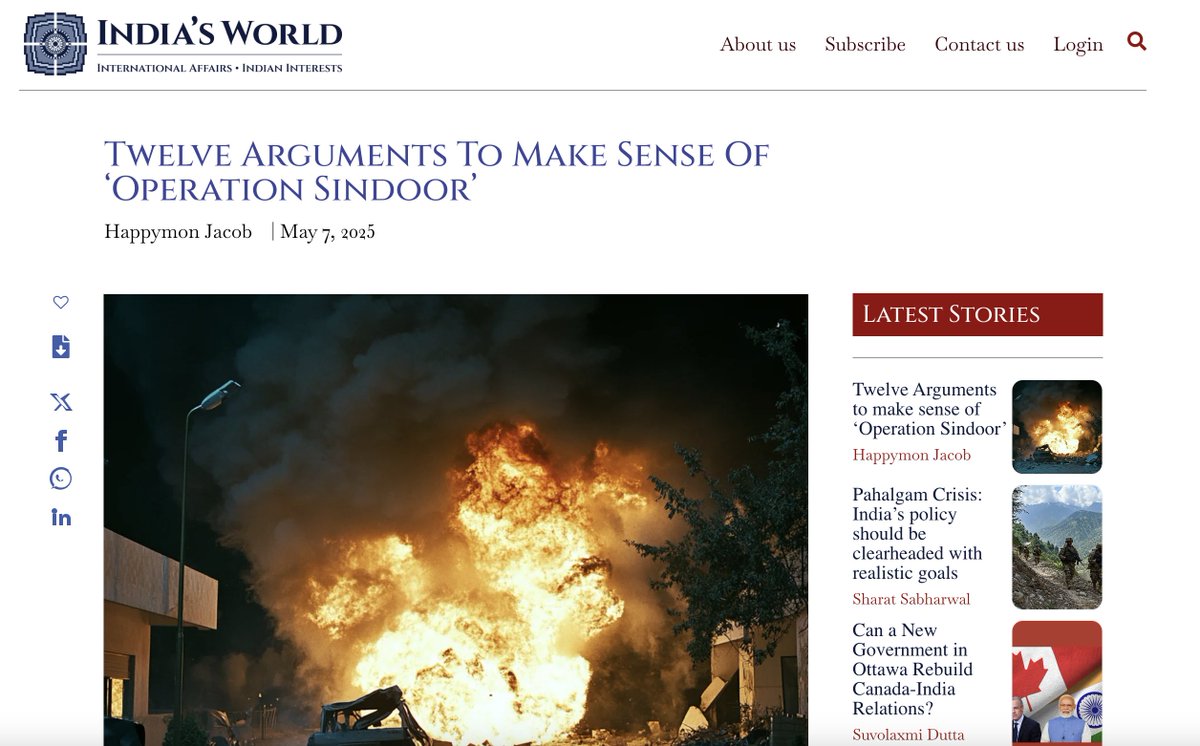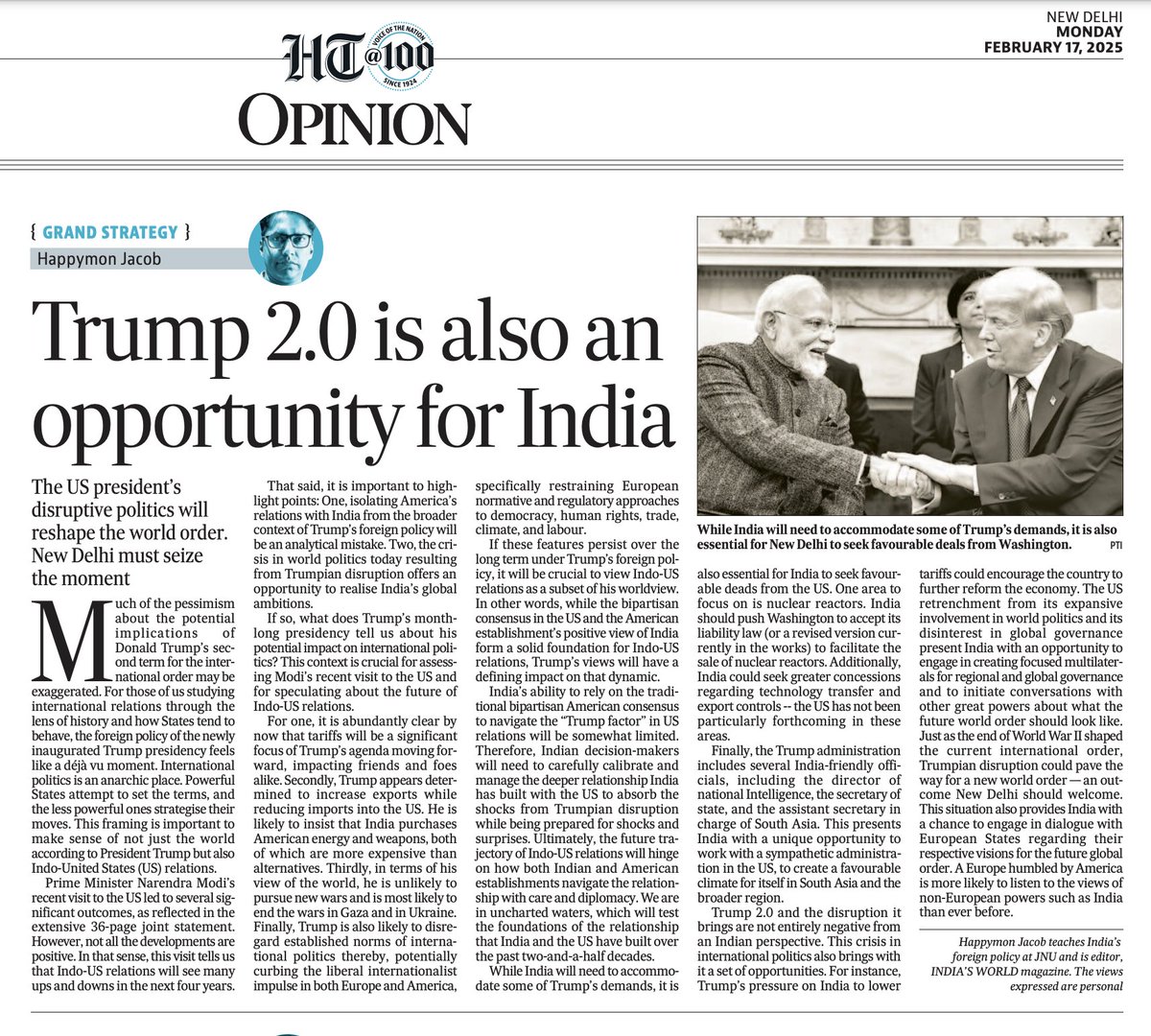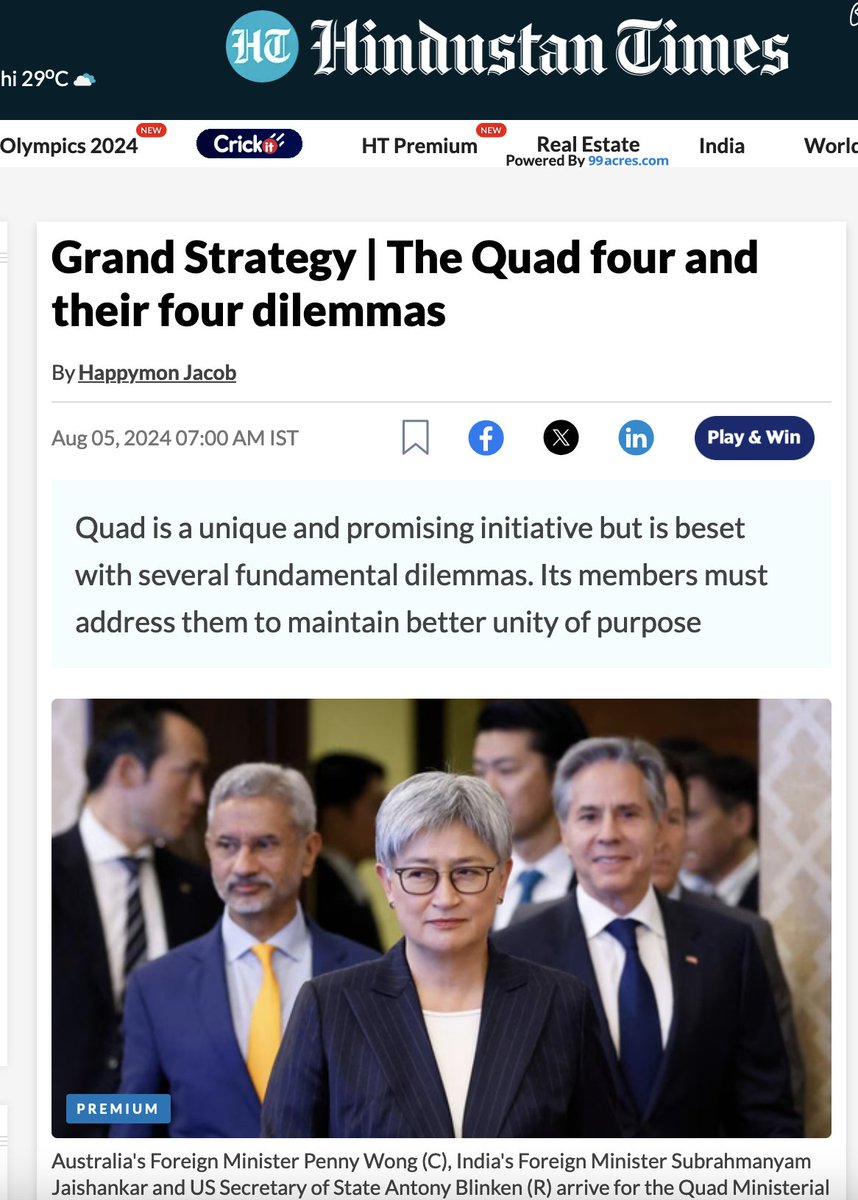In my latest article for @IndiasWorld_mag, I outline "Nine Elements of India’s Emerging Strategy Against Terrorism" which I term "Deterrence by Exhaustion".
1. Assured conventional retaliation against sub-conventional attacks.
This strategy involves publicly declaring a conventional military response to Pakistan, unlike 2016, when actions were unannounced and only acknowledged afterwards, and then following through on these commitments. Through the new approach, which entails openly communicating its intentions to Pakistan and the international community, India aims to establish a well-publicised tripwire strategy, which may deter Pakistan from crossing certain red lines. India not only wants to take punitive action but also wants to be seen as doing so openly and visibly. Setting public redlines for the adversary to enhance deterrence is the objective here.
1. Assured conventional retaliation against sub-conventional attacks.
This strategy involves publicly declaring a conventional military response to Pakistan, unlike 2016, when actions were unannounced and only acknowledged afterwards, and then following through on these commitments. Through the new approach, which entails openly communicating its intentions to Pakistan and the international community, India aims to establish a well-publicised tripwire strategy, which may deter Pakistan from crossing certain red lines. India not only wants to take punitive action but also wants to be seen as doing so openly and visibly. Setting public redlines for the adversary to enhance deterrence is the objective here.

2. This strategy aims to progressively increase the costs, stakes, scope, and intensity of the response with each escalation following a terror attack.
Since the 2001 Parliament attack, there has been a gradual escalation in the intensity of India’s response to terrorism, culminating in the 2025 Pahalgam attacks. The most intense Indian response to terrorism so far was seen this month which combined unprecedented degrees of kinetic and non-kinetic responses.
Since the 2001 Parliament attack, there has been a gradual escalation in the intensity of India’s response to terrorism, culminating in the 2025 Pahalgam attacks. The most intense Indian response to terrorism so far was seen this month which combined unprecedented degrees of kinetic and non-kinetic responses.
The underlying idea is that if Pakistan uses terrorism as a cost-effective strategy to pressure India and internationalise Kashmir, India’s response should aim to make Pakistan’s strategy costly and unsustainable. Expecting Pakistan not to respond conventionally is unrealistic, but the message about assured conventional retaliation to terror strikes by India is unlikely to be missed out on in Pakistan.
If you focus on Pakistan’s conventional pushback against India’s conventional response, you will miss the point; the point is the rising costs Pakistan has to pay with each iteration of this back and forth.
3. This strategy refuses to accept there is a fundamental distinction between sub-conventional (terrorism) and conventional (military) aggression.
Pakistan has traditionally insisted that sub-conventional domain is distinct from the conventional domain. This had put India in a bind when it came to finding a way to respond to terror attacks from Pakistan.
Pakistan has traditionally insisted that sub-conventional domain is distinct from the conventional domain. This had put India in a bind when it came to finding a way to respond to terror attacks from Pakistan.
Realising India’s dilemma in responding, Pakistan exploited this distinction to paint a doomsday escalatory scenario to prevent Indian military response to terror attacks. If India doesn’t accept that distinction any longer, Pakistan’s ability to exploit that space to carry out/allow/do nothing about terror attacks against India no longer exists. With 2019 and with Operation Sindoor, Delhi has flatly refused to consider these two as two distinct domains.
4. The new Indian strategy seeks to restrict the conflict to the conventional realm.
As part of this strategy, the government seems to be taking steps in both the adoption of means and messaging style during attacks to signal that the conventional attacks are not intended to cross nuclear thresholds.
As part of this strategy, the government seems to be taking steps in both the adoption of means and messaging style during attacks to signal that the conventional attacks are not intended to cross nuclear thresholds.
Early in the conflict, India signalled that its focus was solely on terrorist infrastructure, avoiding attacks on military installations, command and control centres, or civilian targets. This stance was clarified in both 2016 and 2019 as well. However, given the higher levels of escalation this time, it seems the targets extended beyond just terrorist infrastructure as the crisis progressed.
In 2016, 2019, and 2025, India clearly articulated and declared the objectives behind its strikes and punitive measures. As for the non-kinetic measures such as the suspension of the IWT, Indian officials said, whilst announcing the suspension of the IWT, that the treaty would not be reinstated unless Pakistan “credibly and irreversibly” ceases support for cross-border terrorism against India. As for the military response, India clarified beforehand that it was solely targeting terrorist infrastructure, avoiding civilian or military targets.
The Indian objective is to carve out a distinct space above the sub-conventional domain and below the nuclear domain where it can undertake punitive actions in order to respond to terror attacks. So far it has succeeded in doing so. If you focus on the decent job Pakistan may have done in this space, you will miss the point – the point is that India has managed to create this clear and distinct space for future operations if necessary.
5. From an Indian perspective, there is an inherent off-ramp built into the conventional response to terror attacks even if Pakistan might not see it as an off-ramp.
One of the most challenging things to do during a military escalation is to provide off-ramps to the adversaries, a challenge we witnessed during the recent crisis as well. As per the Indian reasoning, there is an inherent off-ramp built into India’s conventional response to terror attacks from Pakistan even if the latter might not see it as an off-ramp.
One of the most challenging things to do during a military escalation is to provide off-ramps to the adversaries, a challenge we witnessed during the recent crisis as well. As per the Indian reasoning, there is an inherent off-ramp built into India’s conventional response to terror attacks from Pakistan even if the latter might not see it as an off-ramp.
In this understanding of the India-Pakistan escalation rungs, Act One is the terror attack, and India’s conventional response to that is Act Two, at which point there is an action-reaction equilibrium.
If Pakistan wants an off-ramp, ceasing hostilities after the Indian response is indeed the off-ramp. But if Pakistan responds to the Indian response, its action is escalatory, forcing India to respond again.
Third parties tend to get involved because the two sides are unable to reach a mutually acceptable off-ramp. At this point, third party involvement itself becomes the off-ramp with both sides being able to argue that the third party forced the other side to stand down.
If Pakistan wants an off-ramp, ceasing hostilities after the Indian response is indeed the off-ramp. But if Pakistan responds to the Indian response, its action is escalatory, forcing India to respond again.
Third parties tend to get involved because the two sides are unable to reach a mutually acceptable off-ramp. At this point, third party involvement itself becomes the off-ramp with both sides being able to argue that the third party forced the other side to stand down.
6. Despite Pakistan’s conventional response being stronger than India might have initially anticipated, Delhi believes that Pakistan’s capacity to sustain a prolonged Indian conventional attack is limited.
India’s strategy is long-term — seeking to exhaust Pakistani resources and capabilities through an extended limited conflict. While Pakistan, having singularly gamed India as its sole strategic challenge for decades, is likely to showcase great performance in the conventional domain, it will find it hard to sustain such a decent performance ever in the long run.
India’s strategy is long-term — seeking to exhaust Pakistani resources and capabilities through an extended limited conflict. While Pakistan, having singularly gamed India as its sole strategic challenge for decades, is likely to showcase great performance in the conventional domain, it will find it hard to sustain such a decent performance ever in the long run.
6. Despite Pakistan’s conventional response being stronger than India might have initially anticipated, Delhi believes that Pakistan’s capacity to sustain a prolonged Indian conventional attack is limited.
India’s strategy is long-term — seeking to exhaust Pakistani resources and capabilities through an extended limited conflict.
While Pakistan, having singularly gamed India as its sole strategic challenge for decades, is likely to showcase great performance in the conventional domain, it will find it hard to sustain such a decent performance ever in the long run.
The objective is to highlight this and convince Pakistan that in the longer run, the payoff structure is skewed against it if it continues to support or encourage terrorism against India.
This policy is based on the belief that over time, India’s consistent conventional responses will influence Pakistan’s incentive structure, leading Pakistan to face high costs with minimal or no returns. India hopes that this will force Pakistan to abandon/modify its sub-conventional strategy.
While Pakistan, having singularly gamed India as its sole strategic challenge for decades, is likely to showcase great performance in the conventional domain, it will find it hard to sustain such a decent performance ever in the long run.
The objective is to highlight this and convince Pakistan that in the longer run, the payoff structure is skewed against it if it continues to support or encourage terrorism against India.
This policy is based on the belief that over time, India’s consistent conventional responses will influence Pakistan’s incentive structure, leading Pakistan to face high costs with minimal or no returns. India hopes that this will force Pakistan to abandon/modify its sub-conventional strategy.
7. There is a strong determination in Delhi to reject external mediation that comes with political conditions, as India believes that such conditions undermine its ability to control outcomes that it seeks from a standoff.
Delhi is willing to accept external mediation, as demonstrated a few days ago with the Americans, provided the intervention is limited to facilitating a technical ceasefire or termination of hostilities.
In that sense, Delhi views de-escalation mediated by third parties as a purely technical issue, not a political one. In other words, while the American president mentioned the resolution of the Kashmir issue after brokering a ceasefire between India and Pakistan, the Indian side simply refused to acknowledge it.
The policy is clear: third parties are welcome to end conventional hostilities but they are not welcome to dictate the political relationship between India and Pakistan thereafter. It is misplaced to view India’s acceptance of ceasefires negotiated by third parties as proof that the country is coming under external pressure.
The correct way to read that is this: Delhi’s objective is to carry out a punitive conventional attack in response to the sub-conventional attack; the objective is not to escalate mindlessly.
If so, third party intervention minus political involvement is something New Delhi would welcome.
In that sense, Delhi views de-escalation mediated by third parties as a purely technical issue, not a political one. In other words, while the American president mentioned the resolution of the Kashmir issue after brokering a ceasefire between India and Pakistan, the Indian side simply refused to acknowledge it.
The policy is clear: third parties are welcome to end conventional hostilities but they are not welcome to dictate the political relationship between India and Pakistan thereafter. It is misplaced to view India’s acceptance of ceasefires negotiated by third parties as proof that the country is coming under external pressure.
The correct way to read that is this: Delhi’s objective is to carry out a punitive conventional attack in response to the sub-conventional attack; the objective is not to escalate mindlessly.
If so, third party intervention minus political involvement is something New Delhi would welcome.
8. In Delhi’s new thinking, there appears to be a desire to refuse to take an off-ramp by acceding to Pakistan’s political demands.
While Delhi would be willing to de-escalate from ongoing conventional military actions which are solely aimed at sending a message that terror acts will not go unpunished, it is unlikely to agree to de-escalation if conditioned on a peace/dialogue process, discussions on Kashmir, or other political concessions.
In other words, in Delhi’s view, a ceasefire is for the limited purpose of ending active hostilities, and not a part of a larger conflict resolution package.
In other words, in Delhi’s view, a ceasefire is for the limited purpose of ending active hostilities, and not a part of a larger conflict resolution package.
9. Finally, India’s strategy appears to involve progressively limiting the scope of bilateral dialogue and talks with each escalation of the conflict.
In Pakistan’s view, an India-Pakistan standoff is a good opportunity to dust up and internationalise the Kashmir issue once again and bring India to the negotiating table on the Kashmir question. Even the recent escalation is likely to be seen in that spirit by Pakistan. India, on the other hand, has a totally opposite view: With each escalation since 2016, India has progressively refused to talk Kashmir with Pakistan. Consider the following. After the 2019 standoff, Delhi was reluctant to engage in direct political dialogue with Pakistan and instead preferred to discuss Kashmir through backchannel negotiations.
With the latest conflict, Delhi may refuse to discuss Kashmir with Pakistan in any format, and future talks are likely to be limited to the conditions under which Delhi might consider reinstating the currently suspended Indus Waters Treaty (IWT). In other words, Delhi has not only progressively narrowed the scope of bilateral talks but has also curtailed the agenda, focusing only on specific issues like the IWT.
Read more on the conditions which may need to be met for this strategy to become successful.
indiasworld.in/deterrence-by-…
indiasworld.in/deterrence-by-…
• • •
Missing some Tweet in this thread? You can try to
force a refresh







